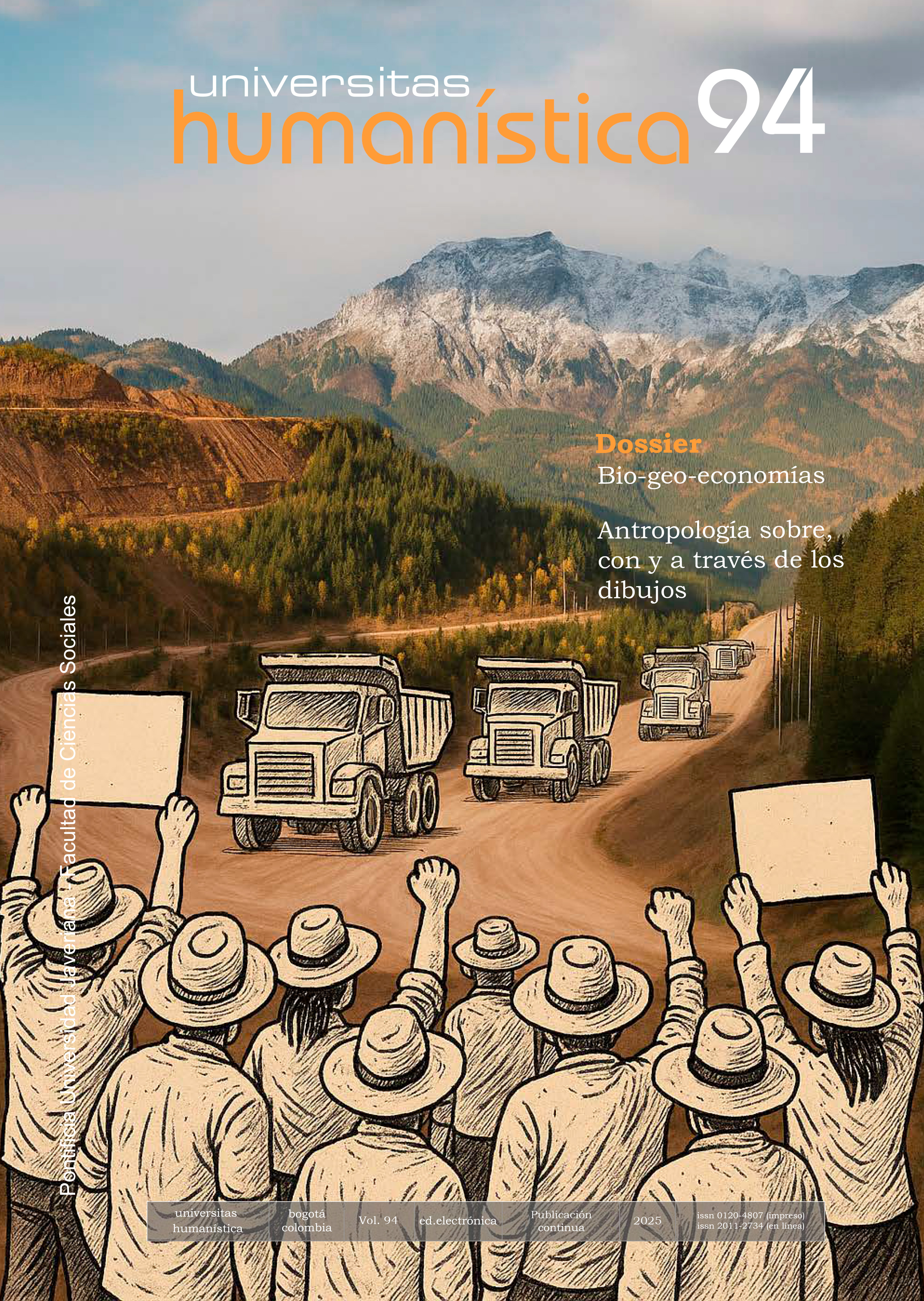Resumen
Este artículo examina el poder de codificación de los dibujos como vehículos para la conceptualización etnográfica. Al comparar un conjunto de dibujos recopilados por el autor en la Amazonía occidental con ilustraciones de guías científicas de campo, este texto explora cómo las imágenes de animales hacen algo más que representar especies. En cambio, se argumenta que los dibujos representan activamente versiones particulares de la naturaleza. Al hacerlo, no solo abren posibilidades para comprender la naturaleza, sino que también establecen límites sobre cómo se puede percibir y experimentar.
Afonso, A. I. (2004). New Graphics for Old Stories: Representation of Local Memories through Drawing. In A. I. Afonso, L. Kurti, & S. Pink (Eds.), Working Images: Visual Research and Representation in Ethnography (pp. 72-89). Routledge.
Anderson, G. (2017). Drawing as a Way of Knowing in Art and Science. Intellect Books.
Austin, J. L. (1962). How to Do Things with Words. The William James Lectures Delivered at Harvard University in 1955. Clarendon Press.
Ayerbe Quiñones, F. (2019). Guía ilustrada de la avifauna colombiana. Wildlife Conservation Society.
Bautista, J. (2012). Interview with Juan Bautista. Personal Archive.
Böhme, G. (1993). Atmosphere as the Fundamental Concept of a New Aesthetics. Thesis Eleven 36(1), 113-126. https://doi.org/10.1177/072551369303600107
Cabrera, J. A., & Molano, F. (1995). Mamíferos Macarena. Asociación para la Defensa de la Macarena.
Cubides, F., Mockus Sivickas, A., Avellaneda, M., González, H., Arcila Niño, O., Molano, A., Acero, H., Pacheco, J. C., & Mosquera Mesa, R. (1989). La Macarena. Reserva biológica de la humanidad, territorio de conflicto. Universidad Nacional de Colombia.
Descola, P. (2017). La Composition Des Mondes. Entretiens Avec Pierre Charbonnais. Flammarion.
Del Cairo, C. (2019). Selvas y gentes (in)cultas: políticas de la cultura y poblaciones amazónicas en los diseños de intervención estatal. In S. Hall, E. Restrepo, & C. del Cairo (Eds.), Cultura: centralidad, artilugios, etnografía (pp. 107-147). Asociación Colombiana de Antropología.
Dufrenne, M. (1973). The Phenomenology of Aesthetic Experience. Northwestern University Press.
Espinosa, N. (2010). Política de vida y muerte. Etnografía de La violencia diaria en la Sierra de La Macarena. Instituto Colombiano de Antropología.
Galvão, E. (1951). Panema: Uma Crença Do Caboclo Amazônico. Revista Do Museu Paulista, 5, 221-225.
Haraway, D. (2016). Staying with the Trouble: Making Kin in the Chthulucene. Duke University Press.
Harris, M. (1998). What It Means to Be Caboclo: Some Critical Notes on the Construction of Amazonian Caboclo Society as an Anthropological Object. Critique of Anthropology, 18(1), 83-95.
Heidegger, M. (1996). The Fundamental Concepts of Metaphysics. World, Finitude, Solitude. Indiana University Press.
Hendrickson, C. (2008). Visual Field Notes: Drawing Insights in the Yucatan. Visual Anthropology Review, 24(2), 117-132.
Hilty, S. (2020). Birds of Colombia. Lynx Edicions.
Hilty, S., & Brown, W. (1986). A Guide to the Birds of Colombia. Princeton University Press.
Hodson, E. (2021). Out into the World: Drawing and the Ethnographic Moment. Drawing Matters. Drawing Research Network. https://blog.lboro.ac.uk/tracey/wp-content/uploads/sites/44/2021/10/Hodson-DRN-Drawing_Matters_2021.pdf.
Hornborg, A. (2001). The Power of the Machine. Global Inequalities of Economy, Technology, and Environment. Altamira Press.
Ingold, T. (2006). Rethinking the Animate, Re-Animating Thought. Ethnos 71 (1): 9-20.
Kashanipour, J. (2021). The Gradual Gaze: Drawing as a Practice of Ethnographic Description. Anthropology and Humanism, 46(1), 81-94.
Kohn, E. (2013). How Forests Think. Toward and Anthropology Beyond the Human. University of California Press.
Latour, B. (2015). Face à Gaïa. Huit Conférences Sur Le Nouveau Régime Climatique. La Découverte-Les Empêcheurs.
Laws, J. M. (2015). The Laws Guide to Drawing Brids. Auduson.
McMullan, M. (2018). Field guide to the birds of Colombia. Rey Naranjo Editores.
Molano, A., Fajardo, D., Carrizosa, J., & Rozo, F. (1988). La colonización de La Reserva de La Macarena. Fondo FEN; Corporación Araracuara.
Morales Martinez, D., Suarez Castro, A., & Lopez-Arevalo, H. (2022). Diversity of Bats of Sierra de La Macarena with Comments on Their Ecological Patterns. MastozoologiaNeotropical, 29(2), 1-35.
Nugent, S. (1993). Amazonian Caboclo Society. An Essay on Invisibility and Peasant Economy. Routledge.
Nugent, S. (2002). Whiter O Campesinato? Historical Peasantries of Brazilian Amazonia. The Journal of Peasant Studies, 29(3), 163-189.
Rabinowitz, A. (2014). An Indomitable Beast. The Remarkable Journey of the Jaguar. Island Press.
Raffles, H. (2002). In Amazonia. A Natural History. Princeton University Press.
Ramírez, M. C. (2001). Entre el Estado y la guerrilla: identidad y ciudadanía en el movimiento de los campesinos cocaleros del Putumayo. Instituto Colombiano de Antropología e Historia; Colciencias.
Roberts, J. (2024). Every Living Thing. The Great and Deadly Race to Know All Life. Doubleday Canada.
Ruiz Serna, D. (2010). Las premisas de la selva. Representaciones de la naturaleza en una zona de colonización campesina. In M. Chaves, & C. Del Cairo, Perspectivas antropológicas sobre la Amazonia contemporánea (pp. 335-361). Instituto Colombiano de Antropología e Historia; Pontificia Universidad Javeriana.
Ruiz-Serna, D. (2015). Threads of Life and Death: A Photo Essay on Hunting and Fishing in Northwest Amazonia. Visual Anthropology Review, 31(1), 73-86.
Taylor, C. (1993). Engaged Agency and Background in Heidegger. In C Guignon (Ed.), The Cambridge Companion to Heidegger (pp. 317-336). Cambridge University Press.
Tsing, A. (2010). Arts of Inclusion, or How to Love a Mushroom. Manoa, 22(2), 191-203.
Tuan, Y.-F. (1998). Escapism. Johns Hopkins University Press.
Willughby, F., & Ray, J. (2020). The Ornithology of Francis Willughby of Middleton in the County of Wearwick Esq. John Martyn.
Wright, C. (1998). The Third Subject: Perpsectives on Visual Anthropology. Anthropology Today, 14(4), 16-22.

Esta obra está bajo una licencia internacional Creative Commons Atribución 4.0.
Derechos de autor 2025 Daniel Ruiz Serna



